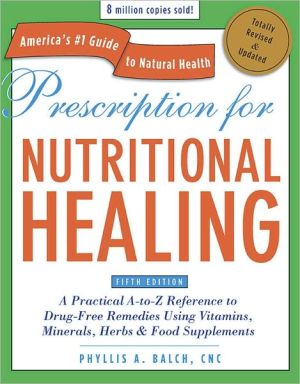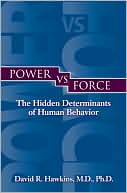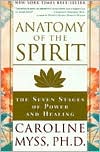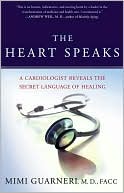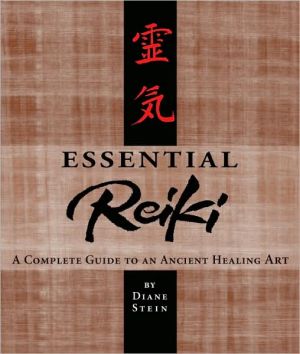Prescription for Nutritional Healing: A Practical A-to-Z Reference to Drug-Free Remedies Using Vitamins, Minerals, Herbs and Food Supplements
The most comprehensive guide to natural health, thoroughly revised and updated with cutting-edge findings in alternative and preventative therapies\ Prescription for Nutritional Healing is the nation's #1 bestselling guide to natural remedies. The new fifth edition incorporates the most recent information on a variety of alternative healing and preventive therapies and new findings on vitamins, supplements, and herbs.\ With an A-to-Z reference to diseases and disorders, updates include:\ How...
Search in google:
Natural health's number-one bestseller for more than twenty years, completely revised and updated. With more than five million copies sold, Prescription for Nutritional Healing is the most trusted, comprehensive source on dietary supplements, vitamins, minerals, and herbs. A pioneer in the field of nutritional healing, Phyllis Balch passionately and meticulously researched and compiled this groundbreaking book. Now, a generation later, her message has more relevance than ever: consume fresh foods, avoid processed foods and those high in saturated fat, and optimize your intake of essential nutrients with the right supplements. Today's well-stocked vitamin and natural-health stores can be confusing, and people need Balch's clear, concise, landmark guide. To help them make sense of the mind-numbing array of choices that are available, readers of Prescription for Nutritional Healing will: - learn the basics of good nutrition; - find out how to balance vitamins and minerals so that the body can properly absorb both; - determine how best to treat 250 problems-from abscesses to wrinkles-using herbs, nutrition, and supplements; and - get the facts on other complementary therapies, like ayurveda, biofeedback, chiropractic care, and more. Prescription for Nutritional Healing is an essential resource for every health-minded consumer.
Chapter One\ Nutrition, Diet, And Wellness\ UNDERSTANDING THE BASICS OF NUTRITION\ Good nutrition is the foundation of good health. Everyone needs the four basic nutrients—water, carbohydrates, proteins, and fats—as well as vitamins, minerals, and other micronutrients. To be able to choose the proper foods, and to better understand why those foods should be supported with supplements, you need to have a clear idea of the components of a healthy diet.\ The Four Basic Nutrients\ Water, carbohydrates, proteins, and fats are the basic building blocks of a good diet. By choosing the healthiest forms of each of these nutrients and eating them in the proper balance, you enable your body to function at its optimal level.\ Water\ The human body is two-thirds water. Water is an essential nutrient that is involved in every function of the body. It helps transport nutrients and waste products in and out of cells. It is necessary for all digestive, absorptive, circulatory, and excretory functions, as well as for the utilization of the water-soluble vitamins. It is also needed for the maintenance of proper body temperature. By drinking an adequate amount of water each day—at least eight 8-ounce glasses—you can ensure that your body has all it needs to maintain good health. (For details on choosing the best water, see WATER in Part One.)\ Carbohydrates\ Carbohydrates supply the body with the energy it needs to function. They are found almost exclusively inplant foods, such as fruits, vegetables, peas, and beans. Milk and milk products are the only foods derived from animals that contain a significant amount of carbohydrates.\ Carbohydrates are divided into two groups—simple carbohydrates and complex carbohydrates. Simple carbohydrates, sometimes called simple sugars, include fructose (fruit sugar), sucrose (table sugar), and lactose (milk sugar), as well as several other sugars. Fruits are one of the richest natural sources of simple carbohydrates. Complex carbohydrates are also made up of sugars, but the sugar molecules are strung together to form longer, more complex chains. Complex carbohydrates include fiber and starches. Foods rich in complex carbohydrates include vegetables, whole grains, peas, and beans.\ Carbohydrates are the main source of blood glucose, which is a major fuel for all of the body's cells and the only source of energy for the brain and red blood cells. Except for fiber, which cannot be digested, both simple and complex carbohydrates are converted into glucose. The glucose is then either used directly to provide energy for the body or stored in the liver for future use. If a person consumes more calories than his or her body is using, a portion of the carbohydrates consumed may be stored in the body as fat. Due to complex chemical reactions in the brain, eating carbohydrates has a mild tranquilizing effect, and can be beneficial for people who suffer from seasonal affective disorder and/or depression.\ When choosing carbohydrate-rich foods for your diet, always select unrefined foods such as fruits, vegetables, peas, beans, and whole-grain products, as opposed to refined, processed foods such as soft drinks, desserts, candy, and sugar. Refined foods offer few, if any, of the vitamins and minerals that are important to your health. In addition, if eaten in excess, especially over a period of many years, the large amounts of simple carbohydrates found in refined foods can lead to a number of disorders, including diabetes and hypoglycemia (low blood sugar). Yet another problem is that foods high in refined simple sugars often are also high in fats, which should be limited in a healthy diet. This is why such foods—which include most cookies and cakes, as well as many snack foods—are usually loaded with calories.\ A word is in order here regarding fiber, a very important form of carbohydrate. Referred to in the past as "roughage," dietary fiber is the part of a plant that is resistant to the body's digestive enzymes. As a result, only a relatively small amount of fiber is digested or metabolized in the stomach or intestines. Instead, most of it moves through the gastrointestinal tract and ends up in the stool.\ Although most fiber is not digested, it delivers several important health benefits. First, fiber retains water, resulting in softer and bulkier stools that prevent constipation and hemorrhoids. A high-fiber diet also reduces the risk of colon cancer, perhaps by speeding the rate at which stool passes through the intestine and by keeping the digestive tract clean. In addition, fiber binds with certain substances that would normally result in the production of cholesterol, and eliminates these substances from the body. In this way, a high-fiber diet helps lower blood cholesterol levels, reducing the risk of heart disease.\ It is recommended that about 60 percent of your total daily calories come from carbohydrates. If much of your diet consists of healthy complex carbohydrates, you should easily fulfill the recommended daily minimum of 25 grams of fiber.\ Protein\ Protein is essential for growth and development. It provides the body with energy, and is needed for the manufacture of hormones, antibodies, enzymes, and tissues. It also helps maintain the proper acid-alkali balance in the body.\ When protein is consumed, the body breaks it down into amino acids, the building blocks of all proteins. Some of the amino acids are designated nonessential. This does not mean that they are unnecessary, but rather that they do not have to come from the diet because they can be synthesized by the body from other amino acids. Other amino acids are considered essential, meaning that the body cannot synthesize them, and therefore must obtain them from the diet.\ Whenever the body makes a protein—when it builds muscle, for instance it needs a variety of amino acids for the protein-making process. These amino acids may come from dietary protein or from the body's own pool of amino acids. If a shortage of amino acids becomes chronic, which can occur if the diet is deficient in essential amino acids, the building of protein in the body stops, and the body suffers. (For more information about amino acids, see AMINO ACIDS in Part One.)\ Because of the importance of consuming proteins that provide all of the necessary amino acids, dietary proteins are considered to belong to two different groups, depending on the amino acids they provide. Complete proteins, which constitute the first group, contain ample amounts of all of the essential amino acids. These proteins are found in meat, fish, poultry, cheese, eggs, and milk. Incomplete proteins, which constitute the second group, contain only some of the essential amino acids. These proteins are found in a variety of foods, including grains, legumes, and leafy green vegetables.\ Although it is important to consume the full range of amino acids, both essential and nonessential, it is not necessary to get them from meat, fish, poultry, and other complete-protein foods. In fact, because of their high fat content—as well as the use of antibiotics and other chemicals in the raising of poultry and cattle most of those foods should be eaten in moderation only. Fortunately, the dietary strategy called mutual supplementation enables you to combine partial-protein foods to make complementary protein—proteins that supply adequate amounts of all the essential amino acids. For instance, although beans and brown rice are both quite rich in protein, each lacks one or more of the necessary amino acids. However, when you combine beans and brown rice with each other, or when you combine either one with any of a number of protein-rich foods, you form a complete protein that is a high-quality substitute for meat. To make a complete protein, combine beans with any one of the following:\ · Brown rice\ · Corn\ · Nuts\ · Seeds\ · Wheat\ Or combine brown rice with any one of the following:\ · Beans\ · Nuts\ · Seeds\ · Wheat\ Most Americans eat too much protein, largely as the result of a diet high in meat and dairy products. However, if you have reduced the amount of meat and dairy foods in your diet, you should make sure to get about 50 grams of protein a day. To make sure that you are getting a great enough variety of amino acids in your diet, add protein-rich foods to meals and snacks as often as possible. Eat bread with nut butters, for instance, or add nuts and seeds to salads and vegetable casseroles. Be aware that a combination of any grains, any nuts and seeds, any legumes (such as beans, peanuts, and peas), and a variety of mixed vegetables will make a complete protein. In addition, cornmeal fortified with the amino acid L-lysine makes a complete protein.\ All soybean products, such as tofu and soymilk, are complete proteins. They contain the essential amino acids plus several other nutrients. Available in health food stores, tofu, soy oil, soy flour, soy-based meat substitutes, soy cheese, and many other soy products are healthful ways to complement the meatless diet.\ Yogurt is the only animal-derived complete-protein source recommended for frequent use in the diet. Made from milk that is curdled by bacteria, yogurt contains Lactobacillus acidophilus and other "friendly" bacteria needed for the digestion of foods and the prevention of many disorders, including candidiasis. Yogurt also contains vitamins A and D, and many of the B-complex vitamins.\ Do not buy the sweetened, flavored yogurts that are sold in supermarkets. These products contain added sugar and, often, preservatives. Instead, either purchase fresh unsweetened yogurt from a health food store or make the yogurt yourself, and sweeten it with fruit juices and other wholesome ingredients. Yogurt makers are relatively inexpensive and easy to use, and are available at most health food stores.\ Fats\ Although much attention has been focused on the need to reduce dietary fat, the body does need fat. During infancy and childhood, fat is necessary for normal brain development. Throughout life, it is essential to provide energy and support growth. Fat is, in fact, the most concentrated source of energy available to the body. However, after about two years of age, the body requires only small amounts of fat—much less than is provided by the average American diet. Excessive fat intake is a major causative factor in obesity, high blood pressure, coronary heart disease, and colon cancer, and has been linked to a number of other disorders as well. To understand how fat intake is related to these health problems, it is necessary to understand the different types of fats available and the ways in which these fats act within the body.\ Fats are composed of building blocks called fatty acids. There are three major categories of fatty acids—saturated, polyunsaturated, and monounsaturated. These classifications are based on the number of hydrogen atoms in the chemical structure of a given molecule of fatty acid.\ Saturated fatty acids are found primarily in animal products, including dairy items, such as whole milk, cream, and cheese, and fatty meats like beef, veal, lamb, pork, and ham. The fat marbling you can see in beef and pork is composed of saturated fat. Some vegetable products—including coconut oil, palm kernel oil, and vegetable shortening—are also high in saturates.\ The liver uses saturated fats to manufacture cholesterol. Therefore, excessive dietary intake of saturated fats can significantly raise the blood cholesterol level, especially the level of low-density lipoproteins (LDLs), or "bad cholesterol." (For more information about cholesterol, see HIGH CHOLESTEROL in Part Two.) Guidelines issued by the National Cholesterol Education Program (NCEP), and widely supported by most experts, recommend that the daily intake of saturated fats be kept below 10 percent of total caloric intake. However, for people who have severe problems with high blood cholesterol, even that level may be too high.\ Polyunsaturated fatty acids are found in greatest abundance in corn, soybean, safflower, and sunflower oils. Certain fish oils are also high in polyunsaturates. Unlike the saturated fats, polyunsaturates may actually lower your total blood cholesterol level. In doing so, however, large amounts of polyunsaturates also have a tendency to reduce your high-density lipoproteins (HDLs)—your "good cholesterol." For this reason—and because, like all fats, polyunsaturates are high in calories for their weight and volume—the NCEP guidelines state that an individual's intake of polyunsaturated fats should not exceed 10 percent of total caloric intake.\ Monounsaturated fatty acids are found mostly in vegetable and nut oils such as olive, peanut, and canola. These fats appear to reduce blood levels of LDLs without affecting HDLs in any way. However, this positive impact upon LDL cholesterol is relatively modest. The NCEP guidelines recommend that intake of monounsaturated fats be kept between 10 and 15 percent of total caloric intake.\ Although most foods—including some plant-derived foods—contain a combination of all three types of fatty acids, one of the types usually predominates. Thus, a fat or oil is considered "saturated" or "high in saturates" when it is composed primarily of saturated fatty acids. Such saturated fats are usually solid at room temperature. Similarly, a fat or oil composed mostly of polyunsaturated fatty acids is called "polyunsaturated," while a fat or oil composed mostly of monounsaturated fatty acids is called "monounsaturated."\ One other element, trans-fatty acids, may play a role in blood cholesterol levels. Also called trans fats, these substances occur when polyunsaturated oils are altered through hydrogenation, a process used to harden liquid vegetable oils into solid foods like margarine and shortening. One recent study found that trans-monounsaturated fatty acids raise LDL cholesterol levels, behaving much like saturated fats. Simultaneously, the trans-fatty acids reduced HDL cholesterol readings. Much more research on this subject is necessary, as studies have not reached consistent and conclusive findings. For now, however, it is clear that if your goal is to lower cholesterol, polyunsaturated and monounsaturted fats are more desirable than saturated fats or products with trans-fatty acids. Just as important, your total calories from fat should not constitute more than 20 to 25 percent of daily calories.\ The Micronutrients: Vitamins and Minerals\ Like water, carbohydrates, protein, and fats, and the enzymes required to digest them, vitamins and minerals are essential to life. They are therefore considered nutrients, and are often referred to as micronutrients simply because they are needed in relatively small amounts compared with the four basic nutrients.\ Because vitamins and minerals are so necessary for health, the U.S. Food and Drug Administration (FDA) has formulated recommended consumption levels for vitamins called recommended daily allowances (RDAs). But, as we will see in VITAMINS in Part One, these allowances do not account for the amount needed to maintain maximum health rather than borderline health, only the amount needed to prevent deficiency diseases. Therefore, the average adult who is not suffering from any specific disorder should obtain more than the RDAs of vitamins and minerals from food sources and/or from supplements. The table on page 6—which includes not just vitamin and mineral supplements, but other supplements as well—should be used as a guideline. Although the amounts listed are safe (they will not cause toxicity), they should be varied according to size and weight. People who are active and exercise; those who are under great stress, on restricted diets, or mentally or physically ill; women who take oral contraceptives; those on medication; those who are recovering from surgery; and smokers and those who consume alcoholic beverages all need higher than normal amounts of nutrients.\ In addition to a proper diet, exercise and a positive attitude are two important elements that are needed to prevent sickness and disease. If your lifestyle includes each of these, you will feel good and have more energy—something we all deserve. Nature has the answers we need to maintain our health, but you need to know what nutrients you are taking to make sure all the pieces of the puzzle fit together.\ Nutrients and Dosages for Maintaining Good Health\ The nutrients listed below are recommended for good health. Daily dosages are suggested; however, before using any supplements, you should consult with your health care provider. The dosages given here are for adults and children weighing 100 pounds and over. Appropriate dosages for children vary according to age and weight. A child weighing between 70 and 100 pounds should be given three-fourths the adult dose; a child weighing under 70 pounds (and over the age of six years) should be given half the adult dose. A child under the age of six years should be given nutritional formulas designed specifically for young children. Follow the dosage directions on the product label.\ Use only quality natural (not synthetic) supplements from a reputable source. Lower priced supplements can mean lower quality, with higher levels of fillers and other undesirable ingredients. Give your body the best—it deserves it. If you cannot locate one or more of the supplements recommended in this book, you can call or write to one of the sources listed in the Appendix.\ \ \ \ \ \ \ \ Vitamins\ Daily Dosages(*)\ \ \ \ \ \ \ \ Vitamin A (retinol)\ 5,000-10,000 IU\ \ \ A carotenoid complex containing beta-carotene\ 5,000-25,000 IU\ \ \ Vitamin B1 (thiamine)\ 50-100 mg\ \ \ Vitamin B2 (riboflavin)\ 15-50 mg\ \ \ Vitamin B3 (niacin)\ 15-50 mg\ \ \ (niacinamide)\ 50-100 mg\ \ \ \ \ \ \ \ Pantothenic acid (vitamin B5)\ 50-100 mg\ \ \ Vitamin B6 (pyridoxine)\ 50-100 mg\ \ \ Vitamin B12\ 200-400 mcg\ \ \ Biotin\ 400-800 mcg\ \ \ \ \ \ \ \ Choline\ 50-200 mg\ \ \ Folic acid\ 400-800 mcg\ \ \ Inositol\ 50-200 mg\ \ \ Para-aminobenzoic acid (PABA)\ 10-50 mg\ \ \ \ \ \ \ \ Vitamin C with mineral ascorbates (Ester-C)\ 1,000-3,000 mg\ \ \ Bioflavonoids (mixed)\ 200-500 mg\ \ \ Hesperidin\ 50-100 mg\ \ \ Rutin\ 25 mg\ \ \ \ \ \ \ \ Vitamin D3 (cholecalciferol)\ 400 IU\ \ \ Vitamin E (d-alpha-tocopherol)\ 400-600 IU\ \ \ Vitamin K (use natural sources such as alfalfa, green leafy vegetables)\ 100-500 mcg\ \ \ Essential fatty acids (EFAs) (primrose oil, flaxseed oil, salmon oil, and fish oil are good sources)\ As directed on label.\ \ \ \ \ \ \ \ Minerals\ Daily Dosages\ \ \ \ \ \ \ \ Boron (picolinate or citrate)\ 3-6 mg\ \ \ Calcium (citrate, ascorbate, or malate)\ 1,500-2,000 mg\ \ \ Chromium (GTF, picolinate, or polynicotinate)\ 150-400 mcg\ \ \ Copper\ 2-3 mg\ \ \ Iodine (kelp is a good source)\ 100-225 mcg\ \ \ \ \ \ \ \ Iron(**) (ferrous gluconate, fumarate, citrate, or amino acid chelate; avoid inorganic forms such as ferrous sulfate, which can oxidize vitamin E.)\ 18-30 mg\ \ \ Magnesium\ 750-1,000 mg\ \ \ Manganese\ 3-10 mg\ \ \ Molybdenum (ascorbate, aspartate, or picolinate)\ 30-100 mcg\ \ \ \ \ \ \ \ Potassium (citrate)\ 99-500 mg\ \ \ Selenium\ 100-200 mcg\ \ \ Vanadium (vanadyl sulfate)\ 200 mcg-1 mg\ \ \ Zinc\ 30-50 mg\ \ \ \ \ \ \ \ Amino Acids(***)\ Daily Dosages\ \ \ \ \ \ \ \ L-Carnitine\ 500 mg\ \ \ Acetyl-L-Carnitine\ 100-500 mg\ \ \ L-Cysteine\ 50-100 mg\ \ \ AcetyI-L-Cysteine\ 100-500 mg\ \ \ \ \ \ \ \ L-Lysine\ 50-100 mg\ \ \ L-Methionine\ 50-100 mg\ \ \ \ \ \ \ \ Taurine\ 100-500 mg\ \ \ L-Tyrosine\ 500 mg\ \ \ \ \ \ \ \ Optional Supplements(****)\ Daily Dosages\ \ \ \ \ \ \ \ Chondroitin sulfate\ As directed on label.\ \ \ Coenzyme [Q.sub.10]\ 30-100 mg\ \ \ Cryptoxanthin\ 110 mcg\ \ \ Flavonoids (citrus fruits and berries)\ As directed on label.\ \ \ Garlic\ As directed on label.\ \ \ \ \ \ \ \ Ginkgo biloba (herb)\ As directed on label.\ \ \ Glucosamine sulfate\ As directed on label.\ \ \ Lecithin\ 200-500 mg\ \ \ Lutein/lycopene\ As directed on label.\ \ \ Pectin\ 50-100 mg\ \ \ \ \ \ \ \ Phosphatidyl choline\ As directed on label.\ \ \ Phosphatidyl serine\ As directed on label.\ \ \ Pycnogenol or grape seed extract (OPCs)\ As directed on label.\ \ \ Quercetin\ 70-140 mg\ \ \ \ \ \ \ \ RNA-DNA\ 100 mg\ \ \ Silicon\ As directed on label.\ \ \ Soy isoflavones (genistein)\ As directed on label.\ \ \ Superoxide dismutase (SOD)\ As directed on label.\ \ \ Zeaxanthin\ 90 mcg\ \ \ \ \ \ \ \ (*) Be careful not to confuse milligrams (mg) with micrograms (mcg). A microgram is 1/1,000 of a milligram. \ (**) Iron should be taken only if a deficiency exists. Always take iron supplements separately, rather than in a multivitamin and mineral formula.\ (***) See AMINO ACIDS for more information. Individual amino acids should not be taken on a regular basis unless used for treatment of a certain disorder.\ (****) See NATURAL FOOD SUPPLEMENTS for more information.\ \ \ \ \ \ \ \ \ Other supplements that you may wish to take for increased energy are:\ · Bee pollen.\ · Coenzyme A.\ · Coenzyme 1 (nicofinamide adenine dinucleotide with high-energy hydrogen, or NADH; sold under the brand name Enada).\ · Free-form amino acid complex.\ · Kyo-Green from Wakunaga of America.\ · N,N-Dimethylglycine (DMG).\ · Octacosanol.\ · Siberian ginseng.\ · Spirulina.\ · Wheat germ.\ In addition, there are many good formulas on the market specifically formulated to help meet the nutritional needs of infants and children, among them Mycel Baby Vites from Ethical Nutrients, a highly absorbable liquid multivitamin formula.\ Synergy and Deficiency\ Data compiled by the U.S. Department of Agriculture indicate that at least 40 percent of the people in this country routinely consume a diet containing only 60 percent of the RDA of each of ten selected nutrients. This means that close to half of the population (and very likely more) suffer from a deficiency of at least one important nutrient. A poll of 37,000 Americans conducted by Food Technology found that half of them were deficient in vitamin B6 (pyridoxine), 42 percent did not consume sufficient amounts of calcium, 39 percent had an insufficient iron intake, and 25 to 39 percent did not obtain enough vitamin C. Additional research has shown that a vitamin deficiency may not affect the whole body, but only specific cells. For example, those who smoke may suffer from a vitamin C deficiency, but only in the lung area.\ Whenever you seek to correct a vitamin or mineral deficiency, you must recognize that nutrients work synergistically. This means that there is a cooperative action between certain vitamins and minerals, which work as catalysts, promoting the absorption and assimilation of other vitamins and minerals. Correcting a deficiency in one vitamin or mineral requires the addition of others, not simply replacement of the one in which you are deficient. This is why taking a single vitamin or mineral may be ineffective, or even dangerous, and why a balanced vitamin and mineral preparation should always be taken in addition to any single supplements. The following table indicates which vitamins and minerals are necessary to correct certain deficiencies.\ \ \ \ \ \ \ \ Vitamin\ Supplements Needed for Assimilation\ \ \ \ \ \ \ \ Vitamin A\ Choline, essential fatty acids, zinc, vitamins C, D, and E.\ \ \ Vitamin B complex\ Calcium, vitamins C and E.\ \ \ Vitamin B1(thiamine)\ Manganese, vitamin B complex, vitamins C and E.\ \ \ Vitamin B2(riboflavin)\ Vitamin B complex, vitamin C.\ \ \ Vitamin B3(niacin)\ Vitamin B complex, vitamin C.\ \ \ Pantothenic acid (vitamin B5)\ Vitamin B complex, vitamins A, C, and E.\ \ \ Vitamin B6(pyricloxine)\ Potassium, vitamin B complex, vitamin C.\ \ \ \ \ \ \ \ Biotin\ Folic acid, vitamin B complex, pantothenic acid (vitamin B5), vitamin B12, vitamin C.\ \ \ Choline\ Vitamin B complex, vitamin B12, folic acid, inositol.\ \ \ Inositol\ Vitamin B complex, vitamin C.\ \ \ Para-aminobenzoic acid (PABA)\ Vitamin B complex, folic acid, vitamin C.\ \ \ \ \ \ \ \ Vitamin C\ Bioflavonoids, calcium, magnesium.\ \ \ Vitamin D\ Calcium, choline, essential fatty acids, phosphorus, vitamins A and C.\ \ \ Vitamin E\ Essential fatty acids, manganese, selenium, vitamin A, vitamin B1 (thiamine), inositol, vitamin C.\ \ \ Essential fatty acids\ Vitamins A, C, D, and E.\ \ \ \ \ \ \ \ Mineral\ Supplements Needed for Assimilation\ \ \ \ \ \ \ \ Calcium\ Boron, essential fatty acids, lysine, magnesium, manganese, phosphorus, vitamins A, C, D, and E.\ \ \ Copper\ Cobalt, folic acid, iron, zinc.\ \ \ Iodine\ Iron, manganese, phosphorus.\ \ \ Magnesium\ Calcium, phosphorus, potassium, vitamin B6 (pyridoxine), vitamins C and D.\ \ \ Manganese\ Calcium, iron, vitamin B complex, vitamin E.\ \ \ \ \ \ \ \ Phosphorus\ Calcium, iron, manganese, sodium, vitamin B6 (pyridoxine).\ \ \ Silicon\ Iron, phosphorus.\ \ \ Sodium\ Calcium, potassium, sulfur, vitamin D.\ \ \ Sulfur\ Potassium, vitamin B1 (thiamine), pantothenic acid (vitamin B5), biotin.\ \ \ Zinc\ Calcium, copper, phosphorus, vitamin B6 (pyridoxine).\ \ \ \ \ \ \ \ There are certain cautions that you should take into account when taking supplements. Antibiotics interfere with the natural balance of normal intestinal flora needed to produce vitamin K, which is necessary for normal blood clotting and maintaining the integrity of the bones. Too much coffee and/or caffeinated soft drinks can interfere with calcium metabolism. Aspirin can irritate the gastrointestinal tract, and may cause gastrointestinal bleeding. Aspirin can also interfere with the absorption of B vitamins and vitamin C. If you are taking aspirin daily for cardiovascular health, it is better to take baby aspirin—studies have shown that it is less irritating to the gastrointestinal tract, and it works just as well as ordinary aspirin.\ (Continues...)\
Preface,vii How to Use This Book,viii Part One Understanding the Elements of Health Introduction,2 Nutrition, Diet, and Wellness,3 Vitamins,13 Minerals,25 Water,35 Amino Acids,42 Antioxidants,53 Enzymes,59 Natural Food Supplements,63 Herbs,85 Part Two The Disorders Introduction,116 Troubleshooting for Disorders,117 Abscess,120 Acid/Alkali Imbalance,122 Acne,125 Adrenal Disorders,129 Age Spots,131 Aging,132 AIDS,138 Alcoholism,147 Allergies,153 Aluminum Toxicity,167 Alzheimer's Disease,168 Anemia,174 Anorexia Nervosa,177 Anxiety Disorder,179 Appendicitis,183 Appetite, Poor,184 Arsenic Poisoning,185 Arteriosclerosis/Atherosclerosis,186 Arthritis,188 Asthma,195 Athlete's Foot,200 Attention Deficit Disorder (ADD)/Attention Deficit Hyperactivity Disorder (ADHD),201 Autism,205 Backache,208 Bedsores,212 Bed-Wetting,214 Bee Sting,215 Bladder Infection (Cystitis),216 Boil,219 Breast Cancer,221 Breastfeeding-Related Problems,229 Engorgement,229 Mastitis (Breast Infection),229 Plugged Duct,230 Sore Nipples,230 Bronchitis,232 Bruising,235 Bruxism,237 Bulimia,238 Bums,241 Bursitis,243 Cadmium Toxicity,245 Cancer,246 Candidiasis,263 Canker Sores (Aphthous Ulcers),266 Cardiovascular Disease,267 Carpal Tunnel Syndrome,275 Celiac Disease,279 Chemical Allergies,281 Chemical Poisoning,283 Chickenpox,283 Chlamydia,285 Chronic Fatigue Syndrome,286 Circulatory Problems,290 Cirrhosis of the Liver,292 Cold Sores (Fever Blisters),295 Common Cold,297 Constipation,300 Copper Deficiency,303 Copper Toxicity,304 Corns and Calluses,305 Crohn's Disease,306 Croup,310 Cystic Fibrosis,311 Dandruff,313 Depression,314 Dermatitis,319 Diabetes,321 Diarrhea,326 Diverticulitis,328 Dog Bite,330 Down Syndrome,331 Drug Addiction (Substance Abuse),334 Dry Skin,337 Ear Infection,340 Edema,342 Emphysema,343 Endometriosis,346 Environmental Toxicity,350 Epilepsy,352 Eye Problems,355 Bags under the Eyes,358 Bitot's Spots,358 Blepharitis,359 Bloodshot Eyes,359 Blurred Vision,359 Cataracts,360 Colorblindness,362 Conjunctivitis (Pinkeye),362 Corneal Ulcer,363 Diabetic Retinopathy,363 Dimness or Loss of Vision,363 Dry Eyes,364 Eyestrain,364 Floaters,365 Glaucoma,365 Itchy or Tired Eyes,366 Macular Degeneration,366 Mucus in the Eyes,367 Photophobia,367 Retinitis Pigmentosa,367 Scotoma,368 Shingles (Herpes Zoster),368 Stye,368 Thinning Eyelashes,369 Ulcerated Eyelid,369 Xerophthalmia,369 Fever,369 Fibrocystic Breasts,371 Fibroids, Uterine,372 Fibromyalgia Syndrome,374 Foodborne/Waterborne Disease,378 Fracture,384 Frigidity,386 Fungal Infection,387 Gallbladder Disorders,389 Gangrene,391 German Measles (Rubella),392 Glaucoma,394 Gout,397 Growth Problems,400 Hair Loss,401 Halitosis (Bad Breath),404 Hay Fever,405 Headache,408 Hearing Loss,413 Heart Attack,417 Heartburn/Gastroesophageal Reflux Disease (GERD),422 Heel or Bone Spur,424 Hemophilia,425 Hemorrhoids,426 Hepatitis,429 Herpesvirus Infection,433 High Blood Pressure (Hypertension),436 High Cholesterol,440 Hives,443 Hyperthyroidism,446 Hypoglycemia (Low Blood Sugar),448 Hypothyroidism,450 Hysterectomy-Related Problems,453 Impotence,455 Incontinence,459 Indigestion (Dyspepsia),460 Infertility,463 Inflammation,466 Influenza,468 Insect Allergy,470 Insect Bite,471 Insomnia,473 Irritable Bowel Syndrome,476 Jaundice,479 Kidney Disease (Renal Failure),480 Kidney Stones,483 Lactose Intolerance (Lactase Deficiency),485 Lead Poisoning,487 Leg Ulcers,490 Legionnaires' Disease,492 Lupus,493 Lyme Disease,496 Malabsorption Syndrome,499 Manic-Depressive Disorder (Bipolar Mood Disorder),502 Measles,504 Memory Problems,505 Ménière's Disease,508 Meningitis,510 Menopausal and Perimenopausal Problems,511 Mercury Toxicity,516 Migraine,518 Mononucleosis,521 Motion Sickness,523 Multiple Sclerosis,525 Mumps,529 Muscle Cramps,530 Nail Problems,532 Narcolepsy,535 Nickel Toxicity,537 Nosebleed,538 Obesity,540 Oily Skin,547 Osteoporosis,549 Paget's Disease of Bone,554 Pancreatitis,556 Parkinson's Disease,558 Peptic Ulcer,561 Periodontal Disease,564 Pneumonia,567 Poison Ivy/Poison Oak/Poison Sumac,570 Poisoning,571 Polyps,574 Pregnancy-Related Problems,575 Anemia,576 Asthma,576 Backache,576 Bladder Discomfort/Infection,577 Bleeding Gums,577 Constipation,577 Coughs and Colds,577 Depression,577 Diabetes, Gestational,578 Dizziness,578 Eclampsia and Preeclampsia,578 Ectopic Pregnancy,579 Edema (Swelling of the Hands and Feet),579 Gas (Flatulence),579 Groin Spasm, Stitch, or Pressure,580 Heartburn,580 Hemorrhoids,580 Insomnia,580 Leg Cramps,581 Miscarriage (Spontaneous Abortion),581 Morning Sickness,581 Nosebleeds and Nasal Congestion,582 Sciatica,582 Skin Problems,582 Soreness in the Rib Area,582 Stretch Marks,583 Sweating,583 Varicose Veins,583 Premenstrual Syndrome,587 Prolapse of the Uterus,590 Prostate Cancer,591 Prostatitis/Benign Prostatic Hyertrophy (BPH),596 Psoriasis,599 Radiation Exposure,601 Raynaud's Disease/Raynaud's Phenomenon,603 Reye's Syndrome,604 Rheumatic Fever,606 Rickets / Osteomalacia,607 Rosacea,608 Scabies,610 Schizophrenia,611 Sebaceous Cyst,614 Seborrhea,615 Senility (Dementia),617 Sexually Transmitted Disease (STD),619 Shingles (Herpes Zoster),621 Sinusitis,624 Skin Cancer,627 Skin Rash,632 Smoking Dependency,635 Snakebite,638 Sore Throat,640 Spider Bite,641 Sprains, Strains, and Other Injuries of the Muscles and Joints,643 Stress,646 Sunburn,651 Thrombophlebitis,653 TMJ Syndrome,656 Tonsillitis,658 Tooth Decay,660 Tuberculosis,662 Tumor,664 Ulcerative Colitis,666 Underweight/Weight Loss,668 Vaginitis,670 Varicose Veins,672 Vertigo,674 Vitiligo,676 Warts,677 Weakened Immune System,679 Wilson's Disease,684 Worms (Parasites),686 Wrinkles,688 Part Three Remedies and Therapies Introduction,694 Aromatherapy and Essential Oils,695 Ascorbic Acid Flush,697 Ayurvedic Remedies,698 Blood Purification,698 Chelation Therapy,699 Oral Chelation Therapy,700 Intravenous Chelation Therapy,701 Chinese Medicine,701 Colon Cleansing,702 Color Therapy (Chromotherapy),703 Crystal and Gemstone Therapy,704 DHEA Therapy,704 Enemas,705 The Catnip Tea Enema,705 The Coffee or Wheatgrass Retention Enema,706 The Lemon Juice Cleansing Enema,706 The Pro-Flora Whey Enema,707 Exercise,707 Fasting,708 Glandular Therapy,710 Growth Hormone Therapy,713 Hair Analysis,713 Homeopathy,714 Hydrotherapy,715 Hyperbaric Oxygen Therapy,716 Juicing,717 Light Therapy,719 Music and Sound Therapy,719 Pain Control,720 Acupressure,721 Acupuncture,721 Biofeedback,721 Breathing Exercises,721 Chiropractic,722 Guided Imagery,722 Heat and Cold Therapy,722 Herbs,723 Hypnotherapy,724 Magnet Therapy,724 Massage,724 Medication,725 Meditation,726 Qi Gong,726 Relaxation Techniques,726 Tai Chi,726 TENS Unit Therapy,727 Using a Poultice,727 Sitz Bath,728 Steam Inhalation,728 Preparing for and Recovering from Surgery,729 Therapeutic Liquids,732 Yoga,732 Appendix Glossary,737 Manufacturer and Distributor Information,746 Health and Medical Organizations,755 Suggested Reading,764 Acknowledgments,767 About the Authors,767 Index,768
\ From Barnes & NoblePhyllis Balch's Prescription for Nutritional Healing books have been consistent front-list and back-list sellers in a store and there's no mystery why: They offer up-to-date information in an accessible form about the most important dietary supplements. Prescription for Nutritional Healing: The A-to-Z Guide to Supplements covers vitamins, minerals, antioxidants, amino acids, herbs, enzymes, phytochemicals, and more. This revised, expanded, 900+-page new edition provides comprehensive, up-to-date information on alternative and preventative therapies. This authoritative guide provides current dosage recommendations, details on how supplements and therapies work, and advice on making the best selections. A must-have reference for your kitchen cabinet library.\ \ \
